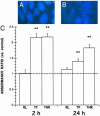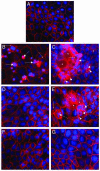Proteinase-activated receptor 1 activation induces epithelial apoptosis and increases intestinal permeability
- PMID: 12960392
- PMCID: PMC196934
- DOI: 10.1073/pnas.1831452100
Proteinase-activated receptor 1 activation induces epithelial apoptosis and increases intestinal permeability
Abstract
Proteinase-activated receptor 1 (PAR1)-mediated inflammation remains poorly understood. Here we characterize previously unrecognized effects of PAR1-induced apoptosis signaling, which contributes to epithelial barrier dysfunction. Incubation of epithelial cells with PAR1 agonists induced apoptosis and increased epithelial permeability in a caspase-3-dependent manner. Similarly, studies in vivo demonstrated that intracolonic infusion with PAR1 agonists increased colonic permeability in mice, and that this effect was abolished by pretreatment with a caspase-3 inhibitor. PAR1 agonists induced tight junctional zonula-occludens 1 disruption and apoptotic nuclear condensation. Investigation into signaling pathways showed that these effects were dependent on caspase-3, tyrosine kinase, and myosin light chain kinase. Conversely, the Src kinase inhibitor PP1 augmented zonula-occludens 1 injury and nuclear condensation induced by PAR1 agonists. These results support a role for proteinases and PARs in intestinal disease and provide new directions for possible therapeutic applications of PAR1 antagonists.
Figures






Similar articles
-
Vasoactive intestinal peptide ameliorates intestinal barrier disruption associated with Citrobacter rodentium-induced colitis.Am J Physiol Gastrointest Liver Physiol. 2009 Oct;297(4):G735-50. doi: 10.1152/ajpgi.90551.2008. Epub 2009 Aug 6. Am J Physiol Gastrointest Liver Physiol. 2009. PMID: 19661153
-
A role for proteinase-activated receptor-1 in inflammatory bowel diseases.J Clin Invest. 2004 Nov;114(10):1444-56. doi: 10.1172/JCI21689. J Clin Invest. 2004. Retraction in: J Clin Invest. 2006 Jul;116(7):2056. doi: 10.1172/jci21689r1. PMID: 15545995 Free PMC article. Retracted.
-
Differential regulation of human lung epithelial and endothelial barrier function by thrombin.Am J Respir Cell Mol Biol. 2004 Nov;31(5):517-27. doi: 10.1165/rcmb.2003-0432OC. Epub 2004 Jul 29. Am J Respir Cell Mol Biol. 2004. PMID: 15284075
-
PAR2 activation alters colonic paracellular permeability in mice via IFN-gamma-dependent and -independent pathways.J Physiol. 2004 Aug 1;558(Pt 3):913-25. doi: 10.1113/jphysiol.2004.061721. Epub 2004 Jun 11. J Physiol. 2004. PMID: 15194744 Free PMC article.
-
Proteinase-activated receptor 1 (PAR-1) and cell apoptosis.Apoptosis. 2004 Nov;9(6):729-37. doi: 10.1023/B:APPT.0000045784.49886.96. Apoptosis. 2004. PMID: 15505415 Review.
Cited by
-
Protease-Activated Receptors in the Intestine: Focus on Inflammation and Cancer.Front Endocrinol (Lausanne). 2019 Oct 24;10:717. doi: 10.3389/fendo.2019.00717. eCollection 2019. Front Endocrinol (Lausanne). 2019. PMID: 31708870 Free PMC article. Review.
-
Protease-activated receptors in health and disease.Physiol Rev. 2023 Jan 1;103(1):717-785. doi: 10.1152/physrev.00044.2021. Epub 2022 Jul 28. Physiol Rev. 2023. PMID: 35901239 Free PMC article. Review.
-
Proteinase activated-receptors-associated signaling in the control of gastric cancer.World J Gastroenterol. 2014 Sep 14;20(34):11977-84. doi: 10.3748/wjg.v20.i34.11977. World J Gastroenterol. 2014. PMID: 25232234 Free PMC article. Review.
-
Mucosal mast cell count is associated with intestinal permeability in patients with diarrhea predominant irritable bowel syndrome.J Neurogastroenterol Motil. 2013 Apr;19(2):244-50. doi: 10.5056/jnm.2013.19.2.244. Epub 2013 Apr 16. J Neurogastroenterol Motil. 2013. PMID: 23667756 Free PMC article.
-
Myosin light chain kinase mediates intestinal barrier disruption following burn injury.PLoS One. 2012;7(4):e34946. doi: 10.1371/journal.pone.0034946. Epub 2012 Apr 18. PLoS One. 2012. PMID: 22529961 Free PMC article.
References
-
- Dery, O., Corvera, C. U., Steinhoff, M. & Bunnett, N. W. (1998) Am. J. Physiol. 274, C1429-C1452. - PubMed
-
- Coughlin, S. R. (2000) Nature 407, 258-264. - PubMed
-
- Hollenberg, M. D. & Compton, S. J. (2002) Pharmacol. Rev. 54, 203-217. - PubMed
-
- Buresi, M. C., Schleihauf, E., Vergnolle, N., Buret, A., Wallace, J. L., Hollenberg, M. D. & MacNaughton, W. K. (2001) Am. J. Physiol. 281, G323-G332. - PubMed
-
- Buresi, M. C., Buret, A. G., Hollenberg, M. D. & MacNaughton, W. K. (2002) FASEB J. 16, 1515-1525. - PubMed
Publication types
MeSH terms
Substances
LinkOut - more resources
Full Text Sources
Other Literature Sources
Research Materials
Miscellaneous

